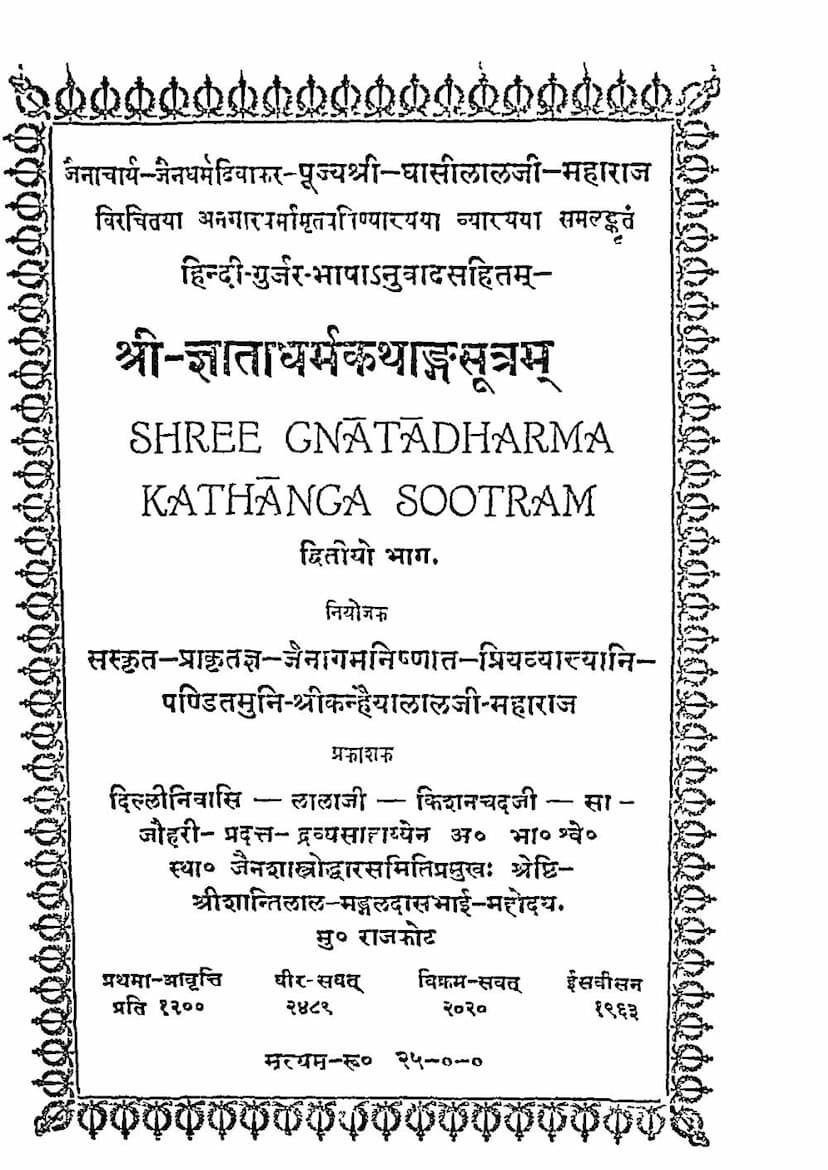Gnatadharmkathanga Sutram Part 02
Added to library: September 1, 2025

Summary
This is a summary of the provided Jain text, "Gnatadharmkathanga Sutram Part 02" by Ghasilal Maharaj. The text is presented in Hindi and Gujarati with Sanskrit and Prakrit original verses, translated and explained with a commentary called "Anagaradharmamritavapini Tika". The provided pages cover introductory material, a table of contents, acknowledgments, and the beginning of the text itself, specifically focusing on the fifth and subsequent chapters.
Here's a breakdown of the key aspects covered in the provided pages:
Introductory and Acknowledgement Material (Pages 1-16):
- Title and Author: The book is "Shree Gnātāharma Kathanga Sootram," Volume 2, authored by Jainacharya Jainadharmadivakar Pujya Shree Ghasilalji Maharaj.
- Publisher and Patronage: Published by A.B. Shwetambar Sthanakvasi Jain Shastroddhar Samiti, Rajkot. The publication was made possible through the financial support of Lala Kishan Chandji Sajohari of Delhi.
- Dedications and Family Introduction: Pages 3-4 provide a detailed introduction to the Chauradia family of Delhi, highlighting their religious and social contributions. It particularly mentions Lala Kishan Chandji, his wife Shrimati Nagina Devi, and their lineage, emphasizing their devotion to Jainism and their patronage of the Shastroddhar Samiti.
- Table of Contents (Pages 5-6 & 8): This section outlines the extensive coverage of the Gnātāharma Kathanga Sutram, Part 02. It lists thirteen studies (Adhyayanas) with numerous sub-topics, including descriptions of cities (e.g., Dwaravati), gardens (Nandanvan), characters from Jain mythology (e.g., Krishnavasudeva, Arishtanemi, Mahavir Swami, various kings, merchants, and householders), philosophical concepts (e.g., rise and fall of beings, the nature of being an Aradhak or Viradhak), and illustrative stories.
- List of Donors and Members (Pages 9-16): This substantial portion acknowledges various individuals and trusts who contributed financially to the publication, categorizing them as "Adya Murabbishri" (major patrons), "Murabbishri" (patrons), and "Sahayak Members" (supporting members). This indicates a community-driven effort to preserve and disseminate Jain scriptures.
Content of the Sutra (Pages 17 onwards):
- Page 17 onwards begins with the text itself:
- Fifth Study (Shailaka): The text starts with the fifth study, focusing on the description of the city of Dwarka (Dvārapati), its description as a divine city, and its comparison to Kushanagari (Alka Puri).
- The Mountain Raivataka: The text then describes the majestic mountain Raivataka, detailing its height, beauty, and the presence of various flora and fauna, as well as celestial beings like Apsaras, Gandharvas, etc.
- Krishna Vasudeva: The arrival of Krishna Vasudeva in Dwarka and his reign is mentioned, highlighting the grandeur of his kingdom and the presence of his extensive retinue.
- Founding of Dwarka and its Rulers: The text continues to describe Krishna Vasudeva's rule and the elaborate assembly (samavasarana) he presided over.
- Chapter on Shailaka King: The text also includes a detailed narrative about King Shailaka.
- Later chapters and stories: The table of contents reveals that the book continues to cover stories of numerous figures, detailing their lives, their adherence to Jain principles, their renunciation, and their attainment of liberation. The chapters touch upon the lives of kings like Balraj, Mahabal, and others, as well as prominent lay disciples like Dhanpati, Sudarshan Seth, and the celestial beings. The narrative also delves into concepts like rebirth (jati smaran), renunciation (diksha), and the consequences of actions.
Key Themes and Concepts:
- Narrative Style: The text employs a narrative approach, using stories and biographies of historical and mythological figures within Jain tradition to illustrate Jain principles and teachings.
- Emphasis on Right Conduct (Achar): The detailed descriptions of characters, their adherence to vows (vratas), their renunciation (diksha), and their devotion to austerities (tapasya) highlight the importance of right conduct in Jainism.
- Moral and Spiritual Guidance: The stories serve as examples of the consequences of actions, the importance of detachment from worldly pleasures, and the path to spiritual liberation (moksha).
- The Role of Patronage: The extensive list of donors underscores the historical significance of patronage in the preservation and dissemination of religious texts.
This summary provides a comprehensive overview based on the provided pages. The actual "Gnatadharmakathanga Sutram" is a vast collection of narratives and teachings, and this part 02, as presented, focuses on specific stories and accounts within that larger framework.